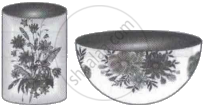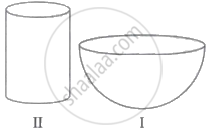Advertisements
Advertisements
प्रश्न
The radii of the circular bases of a frustum of a right circular cone are 12 cm and 3 cm and the height is 12 cm. Find the total surface area and the volume of the frustum.
उत्तर
The height of the frustum cone is h= 12 cm. The radii of the bottom and top circles are r1 = 12cm and r2 = 3cm respectively.
The slant height of the frustum cone is
`l=sqrt((r_1-r_2)^2+h^2`
`=sqrt((12-3)^2+12^2`
`=sqrt(225)`
= 15 cm
The total surface area of the frustum cone is
`=pi(r_1+r_2)xxl+pir_2^2+pir_2^2`
`=pixx(12+3)xx15+pixx12^2+pixx3^2`
= π x 225 x 26 + 144π + 9π
= 378π cm2
Hence Total surface area = 378π cm2
The volume of the frustum cone is
`V=1/3pi(r_1^2+r_1r_2+r_2^2)xxh`
`=1/3pi(12^2+12xx3+3^2)xx12`
`=1/3xxpixx189xx12`
= 756π cm3
Hence Volume of frustum = 756π cm3
APPEARS IN
संबंधित प्रश्न
The number of solid spheres, each of diameter 6 cm that can be made by melting a solid metal cylinder of height 45 cm and diameter 4 cm, is:
A cubical block of side 7 cm is surmounted by a hemisphere. What is the greatest diameter the hemisphere can have? Find the surface area of the solid. [Use `pi = 22/7`]
From a solid right circular cylinder of height 2.4 cm and radius 0.7 cm, a right circular cone of same height and same radius is cut out. Find the total surface area of the remaining solid.
A milk container is made of metal sheet in the shape of frustum of a cone whose volume is 10459 `3/7` cm3. The radii of its lower and upper circular ends are 8cm and 20cm. find the cost of metal sheet used in making container at rate of Rs 1.4 per cm2?
Five identical cubes, each of edge 5 cm, are placed adjacent to each other. Find the volume of the resulting cuboid.
The shape of the gilli used in a gilli-danda game is a combination of

If two solid hemispheres of the same base radius r are joined together along their bases, then curved surface area of this new solid is ______.
If two solid hemispheres of same base radius r are joined together along their bases, then curved surface area of this new solid is ______.
|
Khurja is a city in the Indian state of Uttar Pradesh famous for the pottery. Khurja pottery is traditional Indian pottery work which has attracted Indians as well as foreigners with a variety of tea sets, crockery and ceramic tile works. A huge portion of the ceramics used in the country is supplied by Khurja and is also referred as "The Ceramic Town". One of the private schools of Bulandshahr organised an Educational Tour for class 10 students to Khurja. Students were very excited about the trip. Following are the few pottery objects of Khurja.
Students found the shapes of the objects very interesting and they could easily relate them with mathematical shapes viz sphere, hemisphere, cylinder etc. |
Maths teacher who was accompanying the students asked the following questions:
- The internal radius of hemispherical bowl (filled completely with water) in I is 9 cm and the radius and height of the cylindrical jar in II are 1.5 cm and 4 cm respectively. If the hemispherical bowl is to be emptied in cylindrical jars, then how many cylindrical jars are required?
- If in the cylindrical jar full of water, a conical funnel of the same height and same diameter is immersed, then how much water will flow out of the jar?
A tent is in the shape of a cylinder surmounted by a conical top. If the height and radius of the cylindrical part are 3 m and 14 m respectively, and the total height of the tent is 13.5 m, find the area of the canvas required for making the tent, keeping a provision of 26 m2 of canvas for stitching and wastage. Also, find the cost of the canvas to be purchased at the rate of ₹ 500 per m2.


